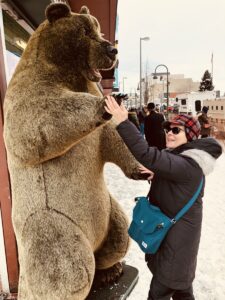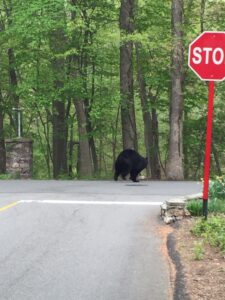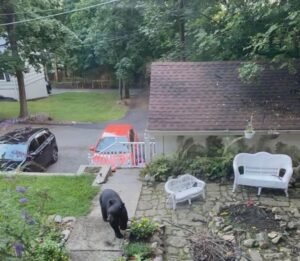Gotta Love Media Hype
Just as the summer camping season began our local newspaper ran a story about dangerous animals. Snakes, bears, and mountain lions. It was scary enough to keep anyone out of the woods or campsite.
Are they really dangerous? Well, we’ve been tromping through woods, deserts, wetlands, canyons, and mountains for nearly 70 years in places where these animals sometimes lurk. Here’s what we have learned and had confirmed by “experts” on how to avoid confrontations with them.
Mountain Lions
Over years of hiking and camping in Idaho, Colorado, Arizona, New Mexico, and South Dakota mountain lion range we’ve never seen one. The odds of encountering a lion are minuscule. If one is around, it’s likely hiding or beating a hasty retreat. People are dangerous, by the way.
According to the Mountain Lion Foundation, the odds of being fatally attacked are about one in a billion, or longer odds than winning a billion-dollar lottery. Still, there have been seven fatal attacks in the past 25 years. Our advice: Odds of seeing a lion are amazingly unlikely but if one is spotted, stay a long way away.
Snake Adventures
We’ve unwittingly walked right past rattlesnakes in South Dakota, Idaho, and Iowa, and once spotted a copperhead near our tent in southern Missouri, but we’ve never been threatened by a poisonous snake. But we have had a few snake adventures.
Little Shovel Gets the Job Done
Once, when our family lived in Florida, Marion’s mom hollered for us kids to get inside. She rarely hollered so we did. Then, she told the older kids to get the neighbor. She had been hanging clothes when a coral snake wandered by. Mom, at all of 4’10” grabbed a huge shovel and pinned the snake in the sandy soil. Our neighbor came over with a little toy shovel, chopped up the snake, and pitched it into the wood pile. The very one where we used to sit in and eat oranges after playing in the orange grove. We found a new place to sit.
Billy Goat Gruff Adventure
When we were new to Iowa Byron Arnold, then a science teacher at Washington High School in Cedar Rapids, took us rattler hunting. Just to see them, not to hurt them. Byron and Rich took off with long strides while Marion, with shorter legs, and curiosity about the emerging wildflowers lingered. Realizing she’d lost sight of the guys, she hopped onto a large flat rock to be greeted in “Billy Goat Gruff” style by a timber rattler underneath inquiring, “Who’s that walking on my rock roof?” Yipes! Now what? Backing up to the far edge, she used her best movement science technique of the running LONG jump off the rock and sprinted across the stone-littered open woods. BTW, the guys had walked right past that rock and never disturbed the gentlemanly timber rattler.
Aptly Named Park In South Dakota
When camping at Snake Creek Campground in South Dakota on a boiling hot summer day, we decided to walk widely mowed paths to the beach. The name of the park is aptly named. Usually, we walk side by side. That day we were going single file when Marion spotted an unusual shape on the edge of the path. A prairie rattler is known to be mean. She called to Rich to watch out. He then stepped closer for a better look. GAAK! The snake kindly retreated. We took the long road back to the tent and slept uneasily that night.
Stay Away From the Sharp End
At an Outdoor Writers Conference years ago, a dog handler who trains hunting dogs to stay away from the sharp end of the snake calculated that for every snake people actually see on a ramble, they have likely passed dozens of unseen snakes over their hiking years. Snakes avoid confrontation. Because people are dangerous!
Snake Facts
According to the University of Florida, the odds of being bitten are about one in 37,500. The chart on the webpage reveals the thousands of people who die from lung cancer and auto accidents. But people still smoke or live in polluted areas and drive cars. So why are we freaked about snakes? Publicity.
With modern antivenoms, very few people die of snakebite. Most bites occur when people handle or molest a snake. Our advice: Watch where you step or put your hands (i.e. if rock climbing in snake country). If you spot a snake, stay away from it. Never attempt to irritate it or pick one up.
Bear Stories

Close up with bears
Now, Bears are a different story. They range through most of the country but usually stay out of sight and away from people. And there are exceptions. Rich’s cousins tell a hilarious story of a bear climbing into the New Jersey suburban home, helping itself to kitchen goodies, and leaving its paw print on the wall as it left, all while the cousin and aunt huddled in the bedroom. Where was their cell phone? In the kitchen!
Friends of Marion’s in New Hampshire have bear adventures we’ve blogged about on Winding Pathways. And, in suburban New Jersey bears are routinely sighted at Cedar Lake. Marion has not been fortunate to see one, because she always smokes a stinky cigar from Denville Smoke Shop – obviously, this tactic works as bear repellent.
But, bears ARE around in suburban areas.
- Suburban NJ has some prolific and big bears.
- Picket fence torn apart by a hungry spring-time bear.
- Bears make themselves at home anywhere.
Bear Facts
According to the National Park Service, the odds of a park visitor being attacked by a bear are one in 2.7 million. They are spreading and can cause mischief. Our advice: Keep a clean camp. Never leave food or other alluring objects with aromas (toothpaste, deodorant, perfumes in a tent. {why would one use any of these on a camp trip, anyway?} If a bear is spotted, stay a long way away, make noise, and slowly walk away from the animal.
What Animals Are Dangerous?
The best way to avoid trouble with any wild animal is to keep your eyes open and avoid conflict by staying a long way away.
Lions, snakes, and bears aren’t terribly dangerous but some animals are. Worldwide the most dangerous wild animal by far is the mosquito! According to the Advocates Injury Attorneys, the animals most likely to kill someone in the United States in order are:
- People. Homicides.
- Dogs.
- Deer. They don’t attack people. Deaths result from collisions with cars.
- Horses and Cows
- Bees, hornets, and wasps
At Winding Pathways, we encourage people to camp, hike, and enjoy the outdoors in their yards. Dangerous animals are not so abundant.
Threats posed by mountain lions, bears, and snakes are tiny and many can be prevented by using caution and common sense. Be cautious but go outside and PLAY!




